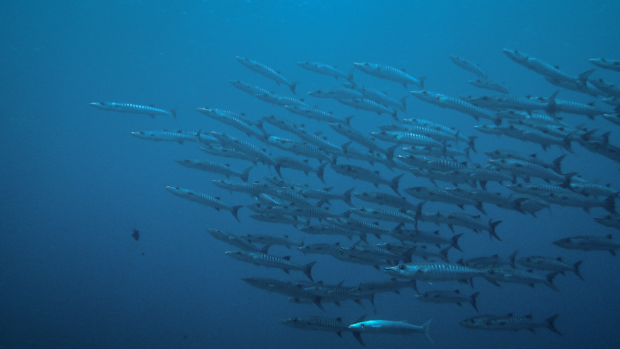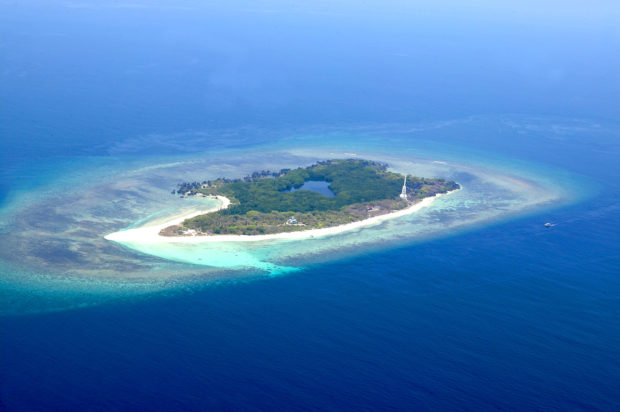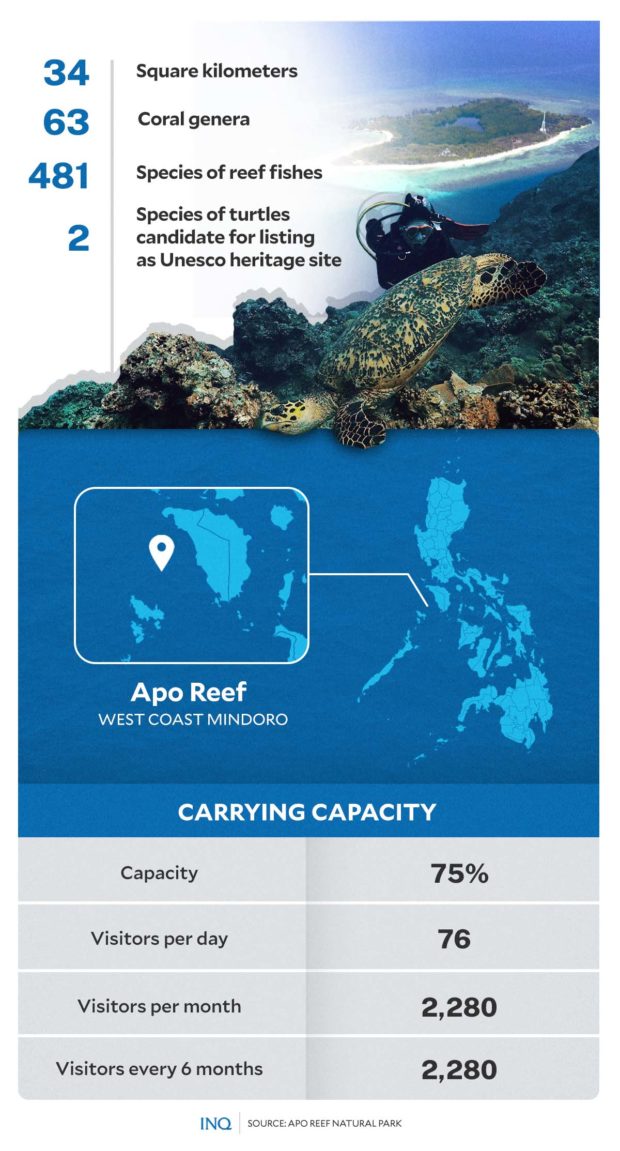Apo Reef ‘cautiously’ coming back to life
MANILA, Philippines—Almost two years after ecotourism nosedived due to the COVID-19 pandemic, Apo Reef Natural Park (ARNP) is now slowly coming back to life as it “cautiously” draws a steady stream of local and foreign visitors.
Before the pandemic hit the country, Apo Reef, hailed as a mecca or haven for divers and travelers alike, was booming with tourists. With a full carrying capacity of 104 visitors per day, the island was earning at least P8 million per year.
However, due to long lockdowns and strict restrictions due to COVID-19, the volume of visitors in the natural park drastically decreased. As tourism slumped, so did the park’s revenues.
“[T]he park could not even [raise] enough money to meet its operating expense at P6 million a year,” the ARNP said in a statement.
Krystal Dayne Villanada, ARNP protected area superintendent of the Department of Environment and Natural resources (DENR), previously said that Apo Reef lost about 2,500 tourists from March to June 2020 alone, or about P4 million in income from park and diving fees.
Article continues after this advertisementREAD: Apo Reef turtle sightings increase during lockdown
However, as the country slowly reopens its doors to local and foreign tourists, Apo Reef Park is slowly recovering from the impact of the COVID-19 pandemic.
Article continues after this advertisementComing back to life
A steady stream of visitors has been coming to Apo Reef this year. In the past few months, the natural park saw “an almost triple growth” of visitors—from 41 in April to 115 in September.
Amid these promising numbers, ARNP planners projected that the volume of visitors will continue to grow, despite the unique policy imposed on the park to manage the growth of its tourist traffic.
According to the natural park’s planners, tourist volume on the island should not exceed 75 percent of the protected area’s full carrying capacity.
This means that only 76 persons are allowed to enter and tour the park per day—around 2,280 visitors per month or at least 13,680 for six months.
“Actual figures are even more encouraging,” the natural park’s planners said.
“Since January this year, with only 537 tourists, the park generated P437,709 in revenues. Even as it limits its visitor arrivals to the 75 percent capacity, the steady stream of visitors augurs well for higher income.”
The planners said two key developments have “brought back the 15,799-hectare natural park to life.” One was in April when the park was reopened to the public as the country began to relax its COVID-19 health protocols.
The other was when the worldwide Marine Conservation Institute conferred the prestigious Platinum Blue Park Award to Apo Reef in ceremonies at the United Nations Ocean Conference in Lisbon, Portugal last July.
READ: Apo Reef Natural Park bags int’l marine conservation award
Villanada said the award is “a testament to the more than two decades of hard and innovative work of different sectors for the conservation and protection of the natural park.”
The Blue Park Award acknowledges outstanding efforts by the national government, non-profit organizations, marine protected area managers, and local communities to protect marine ecosystems.
Amid the tourist influx to the island, the planners assured that various agencies, NGOs, and scientists have been working closely to monitor and protect Apo Reef. DENR has also implemented its Green Fin and training on the computation of the carrying capacity of the island.
Hurt but also healed
Although the park suffered losses, especially at the height of the pandemic, Villanada said it also had the chance to regenerate.
“Since there were no tourists to be monitored during the lockdown, our rangers were able to patrol the whole vicinity more effectively and also monitored the emergence, for example, of the pawikan,” she said.
In September 2020, when the province of Occidental Mindoro was closed to visitors, the number of critically endangered hawksbill (Eretmochelys imbricata) and green sea turtles (Chelonia mydas) in Apo Reef doubled.
At least 29 sea turtles were sighted on the island in August of that same year, which was almost twice the 15 seen inside the 15,799.23-hectare natural park in 2019.
READ: Apo Reef turtle sightings increase during lockdown
Last year, 17 new turtle nests and six new bird sightings have also been recorded at Apo Reef. One was a Chinese grosbeak (Eophona migratoria), which so far is only the third record in the country and the first in Mindoro.
READ: PH ecotourism sites: Hurt but also healed by COVID-19 travel restrictions
Tourists’ haven
“The park is Asia’s largest atoll-like reef and the second largest in the world—next only to Australia’s Great Barrier Reef. Its 34-square-kilometer reef is home to at least 63 genera of corals, 481 species of reef fishes, and 2 species of turtles,” said the ARNP planners.
The DENR Biodiversity Management Bureau (then Protected Areas and Wildlife Bureau) also lists the park for consideration as a UNESCO World Heritage Site.
Apo Reef, which is also largely covered with mangrove forest, also hosts the world’s second-largest contiguous coral reef and attracts divers around the globe. The coral reefs serve as home to thousands of fish species, protecting shores against strong waves and providing fish for food to people.
“The reef also helps in carbon sequestration thru the mangroves and seaweeds. Apo Reef Park also serves as a spawning ground for fish and corals, among others,” ARNP planners said.
Within the park is also a 134-foot-high lighthouse that gives one a 360-degree view of the whole island and ocean.
“Apo Reef is where you can sink your feet in the softest salmon pink sand, framed by a most pristine and turquoise blue-colored water. And while you take a dip into warm and shallow waters, the friendliest green sea hawksbill turtles greet you before snacking on the seagrass and colorful hard corals.”
“Remember, these are endangered species, so handle them with care when you visit this beautiful paradise,” Villanada said.



